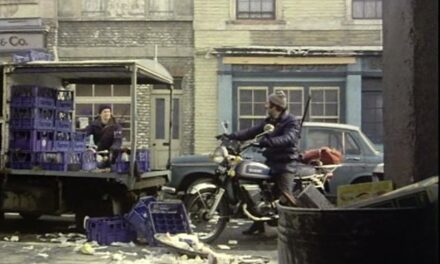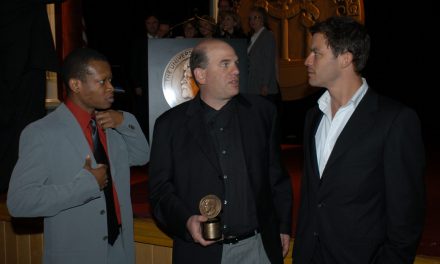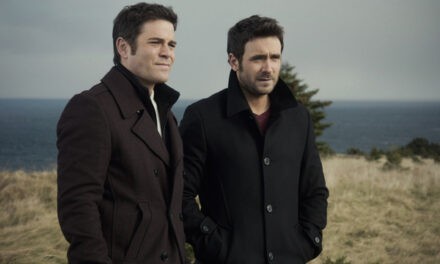In seeking to capture and manage attention within a competitive media landscape, promotion has become a major component of broadcast output, from the exponential increase in promos, logos, idents and trailers, to new forms of branded and interactive content. In this broadcast ecology an industry sector has emerged specializing in promotional communication and digital screen design. Yet this industry has been overlooked in media and screen studies. While critics such as Jonathan Gray, Max Dawson and Lisa Kernan have argued for the importance of analyzing the paratexts that surround films and TV shows, promotion is still often relegated as a professional and creative discipline within academic and industry discourse. In this blog I want to argue for the value of studying TV promos, and the companies that produce them, as creative practices in their own right, that have value and meaning beyond the way in which they might shape viewers’ relationships with the programmes that they are aiming to promote.
This research stems from a year long project that I’m currently undertaking with Paul Grainge that is funded by the AHRC. As part of the project we are working closely with Red Bee Media, the UK’s leading broadcast design company. Based in London’s White City, Red Bee is responsible for a good deal of the promotional texts and interfaces that shape the experience of contemporary UK television. It makes 90 per cent of the BBC’s programme trailers, is responsible (amongst others) for the idents of BBC One and the digital channels BBC Three and Dave, and has carried out a host of promotional work for TV networks in Europe, America and East Asia, from Discovery International and BBC America to CCTV’s Olympic branding for the Beijing Games. This little montage showcases some of their work for the brand identity for BBC One.
In addition, Red Bee digitally transmits the entire output of the BBC, Channel 4, UKTV and Virgin Media and has helped develop content discovery systems such as the BBC iPlayer. Formerly part of the BBC, it’s now a private company employing over 1,500 staff. Our research focuses on the creative side of its business, and one of our aims in working with Red Bee is to examine the artistic and cultural value of television promotion.
So what might it mean to understand and analyse the creative practices and cultural values of promos and idents? To begin thinking about this, I want to focus on one example of Red Bee’s recent promotional work for the BBC, Planet Earth Live (BBC One, May 2012). In doing so, I want to ask what kind of expertise Red Bee were selling to the BBC, what the meanings of the texts produced might be, and what values we might attribute to the texts and to the creative practices of producing them.

The development of Red Bee’s promotional campaign for Planet Earth Live has been one of the projects that we have been following as part of our work with Red Bee. These kinds of promotional campaigns are the primary form of creative work that Red Bee undertakes for broadcasters. Planet Earth Live was, however, a particularly high profile programme for the BBC. Broadcast live from six countries in five different continents over three weeks, Planet Earth Live was a large-scale piece of event television. The programme combined the high production values and spectacle of the natural history programme Planet Earth (narrated by David Attenborough and sold to over 100 countries) and the immediacy and accessibility of Springwatch (presented by Chris Packham and others using live feeds and webcams to reveal the trials and tribulations of British wildlife each Spring). With Planet Earth Live the BBC aimed to broaden the audience for its natural history programming, drawing on the popular address of presenters Richard Hammond and Julia Bradbury, in order to attract 25-45 year-olds with young families.
The BBC asked Red Bee to generate and implement ideas that would promote the series and maintain audience interest over the three weeks that it was broadcast. There were two central elements to the expertise that the BBC was seeking from Red Bee around Planet Earth Live. First, there are what we might term ‘brand’ elements related to the BBC’s brand and reputation in natural history and the brand identity of BBC One. Second, there are what we might call (borrowing an industry term) the ‘ATV’ (appointment to view) elements concerned with generating and maintaining awareness of the series before launch and during broadcast.
- Branding
Although Planet Earth Live was a new concept aimed at broadening the audience for natural history programming, it was important for the BBC that it maintained the standards that the corporation had established in wildlife documentary as a key brand for the corporation in terms of its public service and commercial output (see Helen Wheatley’s excellent article on BBC natural history programming). The very title of the series associated it with the flagship BBC natural history programme Planet Earth, co-produced with Discovery in 2006.

The promotional campaign developed by Red Bee needed to draw on the Planet Earth branding and its associations with the quality of BBC natural history, while making it bespoke for Planet Earth Live by adding an element of liveness and fun. We can see this in the pre-launch promo created by Red Bee, which builds on the established visual iconography of the Planet Earth brand.
Here we can see an attempt to combine the high production values of BBC natural history with the informal, everyman address brought by Richard Hammond – conveying the qualities of the programme and how it fits into the BBC brand. The relationship between the programme and the BBC brand is reiterated through the creation of a bespoke ident based on the Planet Earth Live trailer and titles.
According to Emma James, Account Director for BBC One at Red Bee, bespoke idents are reserved for large event programmes, including all natural history programming. Event programmes like Planet Earth Live reinforce BBC One’s channel positioning: ‘unite and inspire’, and its personality and tone of voice: ‘big, inclusive and generous’ by aiming to bring together different generations and draw new audiences to natural history. The visual scale of the ident and the launch trailer positions Planet Earth Live as ‘big’ in its ambition and demonstrates to viewers the importance of the programme to the channel. Red Bee, with its expertise in brand identity (and in particular television ident design and the specificities of the BBC channel brands) understands the particular kind of relationship between programme and channel brand identity and could sell the BBC expertise in developing promos that function as, and support, a channel brand identity.
- ATV: appointment to view
In today’s competitive media environment broadcasters have to work far harder to capture viewers, and companies like Red Bee Media sell them the expertise to do this. An example of this for Planet Earth Live was the ‘BBC One logo countdown’, which demonstrates the integration of branding and ATV aims. Here Red Bee gave the different production teams for the series red rectangular blocks with the BBC One logo on them and asked them to film short bumpers in their locations with the logo in shot. Red Bee added a graphic counting down the number of days to go in order to generate buzz before the bumpers were broadcast and placed on the Planet Earth Live website.
While these bumpers build anticipation they also clearly situate Planet Earth Live as a BBC One event, again tying the programme to the channel and bringing the channel to life (as something to be interacted with, played with, to be curious about). The short films are full of intrigue and emotion – what is the animal going to do, how exciting and close was that encounter? This is an example of the ways in which short form content can convey an extraordinary amount in a very short space of time.
If these bumpers helped to generate anticipation before the series, Red Bee also developed ATVs to be shown during the transmission of the series.

Termed ‘cliff-hanger’, they drew on elements of jeopardy from the last episode – ‘Will the meerkat survive that snake bite?’ – reminding viewers of specific moments and encouraging them to return for the next episode. These ATVs focused on maintaining excitement between broadcast episodes of the programme, placing the emphasis of the campaign on generating viewers for the live broadcast episodes. This example reminds us that despite the significant changes wrought by digital technologies, most television viewing still takes place live.
(http://www.thinkbox.tv/server/show/nav.1263)
Programmes like Planet Earth Live are specifically designed to encourage live viewing and Red Bee’s promotional campaign worked to reinforce this.
The programme itself was not entirely successful in achieving its aims, with some viewers and critics complaining about the use of non-expert presenters such as Richard Hammond and the fact that most of the wildlife footage was not actually transmitted live. While it could be argued that the Red Bee trailers mis-sold the series, I am more inclined to think that the problem here lay with the concept itself which underestimated the difficulty of capturing wildlife live. Nevertheless, this example does demonstrate the role that companies such as Red Bee are playing in providing broadcasters with expertise on how to capture, engage and retain audiences around their broadcast programmes and to use promotion to reinforce brand reputation. Red Bee’s creative solutions focused on creating short form content that tied the programme to the channel, that was entertaining and emotionally engaging, and that acted as a trigger for further activity, aiming to generate conversations around the programme by creating open-ended texts that pose questions to the audience – What must it be like to be that close to wildlife? What is going to happen to the bear cub? And so on. Such short-form promotional content now forms a major part of our experience of broadcasting, being made available to share online as well as being transmitted in the junctions between programmes. It not only shapes our engagement with the programme being promoted but also contributes to a broader discursive construction of the broadcaster itself. The promotional texts created by Red Bee for Planet Earth Live reinforce the construction of natural history programming as public service event television associated specifically with BBC One, as well as positioning the BBC as the home of ambitious, innovative factual programming that appeals to broad family audiences.
Over and above this, these texts demonstrate the level of creativity involved in promo production as an art form in itself. Take the BBC One Logo Countdown films. The 10 second film in which the bear investigates, turns over and repositions the BBC One logo is a charming and intriguing film that functions on a number of levels. This is an emotive text that conveys the excitement and unpredictability of an encounter with wildlife. However, this film doesn’t just work on an emotional level. It also encourages cognitive engagement, inviting us to wonder how the team managed to generate such footage and why the bear interacted with the logo in this way. In many ways, then, this 10 second film encapsulates much of what is appealing about natural history programming in general, although the emphasis here is on asking questions but not providing answers. It is easy to dismiss the skill involved in the creation of this kind of short form content. Mandy Combes (Head of Operations and Business Director at Red Bee) and an ex-children’s television producer, claimed in an interview with us that promotion is one of the few places within the television industry to push the boundaries of creativity, in comparison to programme production which is constrained by increased accountability and tighter budgets. There are a number of reasons for this. The time limits of short form promotional content means that it needs to grab its audience’s attention quickly and to stand out against the higher budget advertising within which it often sits. At the same time, it has higher production values than long-form programme-making (higher budgets per minute of screen time). As such, Mandy argues, promotional content offers a bigger creative challenge than traditional programme-making.
In working in this area I’ve encountered a number of examples of short form promotional content that demonstrate exceptional creativity, generating texts that are intriguing, engaging, entertaining, intellectually stimulating and, often, beautiful. A great recent example is the trailer for Channel 4’s Paralympics coverage. This 90 second trailer, promoted in the press before transmission, was broadcast at 9pm on Tuesday 17 July 2012 across 78 television channels. The film showcases the physical strength and resilience of a range of British Paralympics athletes against the thumping soundtrack of Public Enemy’s ‘Harder Than You Think’.
It doesn’t shy away from their disabilities, but represents each athlete as ‘superhuman’. As the film’s director Tom Tagholm explains, ‘we really didn’t want to shoot around the particular physical attributes of these athletes and their disabilities. We wanted to absolutely embrace all of that – their stance, the ways they’ve adapted to their sport, the ways that they use their bodies.’ The film not only confronts fears and prejudices about the physically disabled body, but also asks the audience to reflect on the cause of the disabilities, depicting a bomb exploding, a car crash and a pregnant woman hearing the news that her child will be disabled. This moment, coming in the middle of the film, humanises the ‘superhumans’ without undermining the broader representation of them as exceptional athletes. While ostensibly a film designed to promote Channel 4’s coverage of the Paralympics, this promo does so much more, challenging assumptions about disabled sport and presenting disability as a story of strength, power, resilience and ability. The film also required significant skill in filming and editing to achieve this impact in 90 seconds (see Channel 4’s own blog about the trailer for more information about how it was shot).
To me, these are captivating short films that need to be understood as so much more than ‘just promotion’ (to call on Dyer’s arguments about entertainment). To understand and interrogate the creative challenges described by Mandy Combes we need to take promotional forms and the industry that produces them seriously and examine them not just as texts designed to sell programmes/channels, but as an increasingly ubiquitous form of cultural content whose meanings, aesthetics and contexts of production deserve the same close attention as the programmes they surround.
Catherine Johnson is a lecturer in the Department of Culture, Film, and Media at the University of Nottingham. She is the author of Branding Television and Telefantasy and co-editor of Transnational Television History and ITV Cultures. Her current research examines the broader creative industry sector that produces promotional material for the screen industries.






